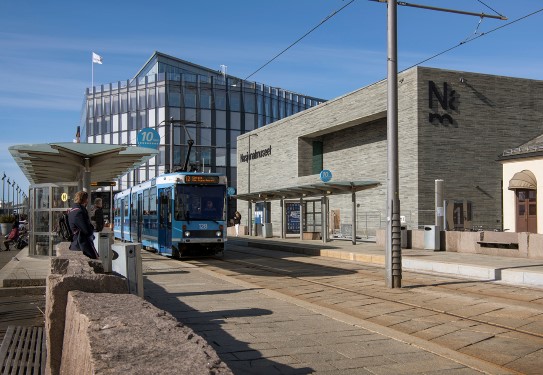The new museum is a place for new ideas, inspiration and compelling cultural experiences. We will make art accessible to everyone and reflect the society and the times we live in.
In the new collection exhibition, older and modern art, architecture, design, arts and crafts, and contemporary art will be presented under one roof and in new settings.
With its new, large exhibition areas, the National Museum can now showcase more of its collection than ever before, as well as presenting a rich programme of temporary exhibitions with Norwegian and international artists.
Giving the city a new venue
Spending time at the museum will be a rewarding and inspiring experience.
The museum plaza in front of the main entrance will be a vibrant urban space and meeting arena with an outdoor restaurant, seating and events.
The Light Hall is the building's signature architectural feature. With its 2 400 square metres it will be a spectacular exhibition venue never seen before in Norway.
From the roof terrace you can enjoy stunning views of Rådhusplassen (city hall square), Aker Brygge and the fjord.
The art collection in completely new settings
In the new museum you will find arts and crafts and design from antiquity to the present day. Here, you can familiarise yourself with everything from the unique Baldishol tapestry and Chinese imperial porcelain to fashion through the ages and the unique Norwegian glass cups of the 18th century – not to mention the latest in contemporary design and arts and crafts.

The second floor is mainly devoted to visual arts from the 15th century to the present day. Among the works you will find here are Dutch and Flemish landscape paintings and still lifes from the 17th century, Johan Christian Dahl's magnificent landscape paintings from the first half of the 19th century, the Munch room with the iconic «The Scream», and the museum's highlights of Norwegian and international contemporary art.
The exhibition will show that art and culture are a central part of history, society and the lives we lead today.
Art, architecture and design meet across art forms and historical periods, allowing you to hear new stories and see new connections.

Read more about the collection exhibition here
What does the art scene of Norway look like right now?
The very first exhibition in the Light Hall takes a new look at contemporary art in Norway. One of the selection criteria for the exhibition is that the artists are not already represented in the museum's collections.
Read more about the opening exhibition in the Light Hall here
About the construction project
- Builder: Statsbygg
- Architects: Klaus Schuwerk (Kleihues + Schuwerk)
- Technical advisors: Rambøll
- Client: The Norwegian Ministry of Culture
When the new National Museum opens to the public in 2022, it will be the largest cultural centre in the Nordic countries. The museum is centrally located on Oslo’s Rådhusplassen (city hall square), making it a perfect place to stop by for an unforgettable cultural experience.
The new National Museum is part of a major project to develop Oslo, opening up the city where it meets the fjord.
The materials should stand the test of time, so that the building can age with patina and dignity.
Klaus Schuwerk, architect

Introducing the Light Hall
- With its 2 400 square metres, the Light Hall will be a spectacular exhibition venue, the first of its kind in Norway.
- 9 000 energy-efficient, adjustable LED lights within the wall will provide a muted light while clearly highlighting the museum in the cityscape.
- The Light Hall will be used for the museum's temporary exhibitions.
- With a ceiling height of approximately seven metres and a length of 130 metres, the hall will be able to accommodate exhibitions on a scale not previously feasible in Norway.
- Depending on requirements, the Light Hall can be used as a single large exhibition space, or two or three smaller ones. Exhibitions can use the full height of the space. Specially designed installations can be included to fill the entire hall – or parts of it. It will be possible to reconstruct houses and even streets.
- If required, the Light Hall can be completely darkened.
- The very first exhibition in the Light Hall will be a declaration of love to Norwegian contemporary art. In this exhibition, the hall will be filled with new Norwegian contemporary art, selected following a comprehensive mapping effort across the country.
- The exterior walls of the Light Hall are made of marble glass, a thin layer of marble between two panes of glass. The marble glass was chosen to give the facade a distinctive character and will have the same translucent effect as alabaster.
Making the big move
Over 100 000 objects must be moved before the new National Museum opens in 2022.
The National Museum's collections include paintings, sculptures, drawings, arts and crafts objects, design objects, architectural models and installations. Everything must be documented, conserved and carefully packed before finding its new home in the pristine new museum.

Hundreds of moving trips
The storage facilities of the new National Museum cover 7 000 square metres and, together with the exhibition area of 14 000 square metres, will house most of the collections. Several hundred trips will be needed to move the collections to their new surroundings.
Some works have not been exhibited in the museum for many years while others have never previously been shown.
These works need a health check; some will also require conservation work. In total, the condition of around 6 500 items will have to assessed before they can be packed up and moved to the collection exhibition in the new museum.
The museum's prints and drawings collection will also be available to the public in the brand new reading room.
Read more about the museum's new logo and visual identity and learn how they were created.
Read the clarification from the architect, Klaus Schuwerk here.
















